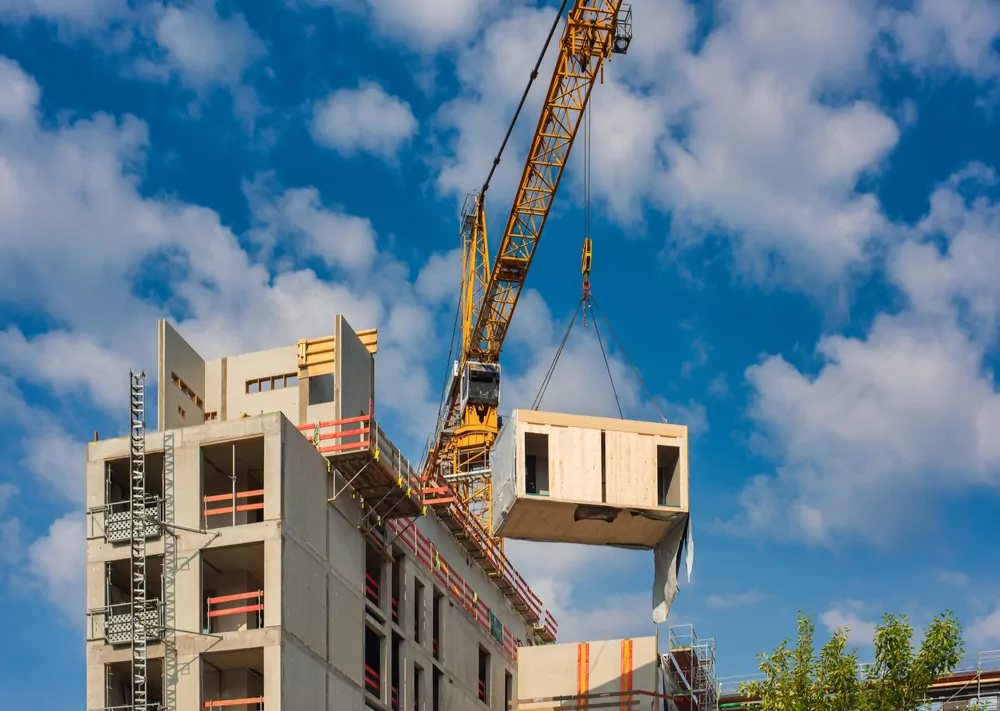
Partner
Head of Energy & Infrastructure | Projects, Infrastructure & Construction | Real Estate
This website will offer limited functionality in this browser. We only support the recent versions of major browsers like Chrome, Firefox, Safari, and Edge.

The ‘net zero’ principle has been making waves in the world of construction for several years now and as market interest steadily increases, more and more contracts are centred on this approach to building. Net zero demands attention from anyone who commissions construction, whether developers, companies or housing associations.
But let’s start at the beginning.
The term ‘net zero’, which extends beyond the construction world, refers to the elimination of greenhouse gas emissions - i.e., carbon dioxide. Net zero can be a target that an organisation is working towards or it can refer to a wholly carbon neutral project.
There are two principal methods of achieving net zero status:
Each method can be standalone but combining the two is more common.
The complicating factor with the net zero principle is that - at present - it has no legal definition in the UK, so no industry standard benchmarks are available. Therefore, interpretations of precisely how to achieve the end goal of zero carbon may differ between organisations, and different techniques and methodologies deployed.
In a construction context, net zero building translates into a variety of techniques, including minimal or zero carbon:
In construction, the term ‘embodied carbon’ is used to describe CO2 emissions produced over the lifespan of a building, from the initial manufacturing of building materials right through to its eventual refurbishment or demolition. In other words, embodied carbon is the carbon footprint of a particular structure. It contrasts with ‘operational carbon’ - greenhouse gas emissions produced during normal business operations.
Both surplus energy - for example, solar power - and sequestered carbon can be sold on for reuse elsewhere, delivering further greenhouse gas reductions.
How to achieve net zero energy building? Energy consumption during the building process plays a central role. For example:
Despite the absence of a legal definition, net zero is something that few construction companies can now ignore, thanks to both market pressure and active government measures to encourage the adoption of zero carbon strategies.
In October 2021, the government published Net Zero Strategy: Build Back Greener, which sets out goals for carbon emission reduction across multiple industries, in an urgent effort to reduce climate change. The policy document explains:
“The science could not be clearer: by the middle of this century the world has to reduce emissions to as close to zero as possible, with the small number of remaining emissions absorbed through natural carbon sinks like forests, and new technologies like carbon capture. If we can achieve this, global emissions of greenhouse gases will be ‘net zero’.”
Build Back Greener identifies construction as an industry at the forefront of a booming green economy, alongside engineering, manufacturing and science.
“The government aims to support action in the construction sector by improving reporting on embodied carbon in buildings and infrastructure with a view to exploring a maximum level for new builds in the future. We recognise there is potential to reduce embodied carbon by way of material substitution where appropriate, such as in timber usage…and resource efficiency approaches, amongst others.”
The increased use of timber in construction is a significant government target for net zero construction because trees absorb and store atmospheric carbon within them, even after felling This means that timber has one of the lowest embodied carbon footprint of any mainstream building material.
Build Back Greener outlines the development of coordinated plans to increase the use of timber within the construction sector, along with the creation of a working group made up of both government officials and industry representatives, focused on increasing timber use and reducing embodied carbon within construction.
The document continues:
“...key opportunities for the safe growth of timber use will be in low-rise buildings using traditional and certain modern methods of construction, and in a wide range of commercial and non-residential settings”
Other net zero construction pledges include:
The current drive towards net zero construction will undoubtedly accelerate in the coming years. Government plans to introduce new Higher Technical Qualifications (HTQs) for construction and engineering students from 2025 which will of course also provide a much-needed boost in skilled workers for a booming industry.
To quote Build Back Greener:
“Future roll-out will continue supporting the development of skills for the transition to net zero as a key government priority. The goal is to grow the number of learners undertaking high-quality level 4 and 5 qualifications to meet skills needs.”
The rollout of new qualifications will be accelerated by a recently launched £18 million growth fund for higher education providers such as universities and colleges. There will be a concurrent effort to forge links with employers in different regions.
There is no doubt that the future workforce will be keen accelerators and users of the 'net zero principle'. Read more on our guide on how to implement net zero contracts here.
As legal advisors, a key part of our role at Foot Anstey is to provide practical legal solutions to tackle clients' contractual and market risks. Today those conversations also extend to climate contracting, as a science-based risk analysis shows us that there is a link between human activity (particularly evident in the activities that govern our built environment) and global warming. This means our legal solutions will also need to extend to dealing with our clients particular climate change requirements and climate risk mitigation strategies in their projects (including their supply chains).
At Foot Anstey we use various means to achieve this. For example, we use (and support) The Chancery Lane Project's database of provisions to provide our clients contractual solutions to monitor / report on emissions, deal with use of sustainable materials in construction projects, etc. We also engage actively with the industry and key stakeholders so that our advice on climate contracting is practical, aligns with the commercial context and is net zero focused.
See how Foot Anstey's clean energy lawyers could help your business or get in touch today!